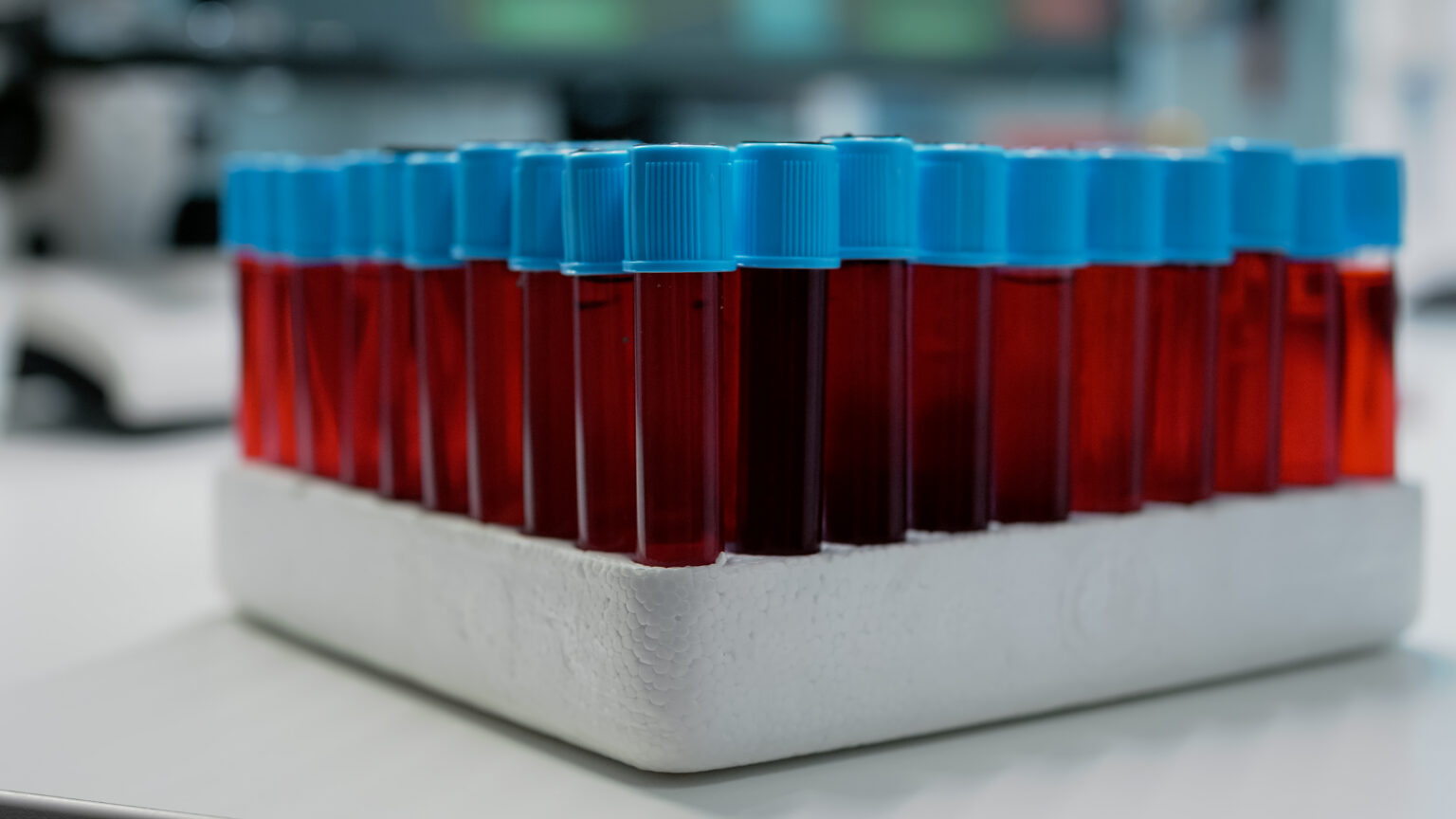Additionally, Hemoglobin determines the red color of blood – in arterial (oxygenated) blood, it is lighter than in venous blood due to the presence of oxygen molecules.
Hemoglobin molecules contain iron. Thanks to the presence of this element, they can effectively fulfill their role related to the transport of oxygen and carbon dioxide. In the case of disorders in the processing of this element in the body or the occurrence of its incorrect concentrations, blood composition abnormalities related to erythrocytes may develop.

Hemoglobin variants are abnormal types of hemoglobin. It comprises heme (the part of hemoglobin that contains iron) and globin (a protein made up of chains of amino acids). Hemoglobin (Hb) is found in all red blood cells (erythrocytes), where it helps transport oxygen from the lungs to the tissues.
Normal hemoglobin types are:
Abnormal forms of hemoglobin arise during changes in the genes encoding the globin protein, which is reflected in changes in the amino acids that make up this protein. These changes may concern the structure of hemoglobin, its function, the rate of formation, and stability.
If a person inherits two abnormal genes (is homozygous for a given mutation), they are considered sick. The severity of manifestation depends on the kind of mutation and differs from individual to individual. The abnormal gene is passed on to offspring.
A person who inherits two abnormal genes encoding the beta chain with different mutations is called a double or compound heterozygote for the described mutations. One of the abnormal beta genes will be passed on to offspring.
Several hundred types of hemoglobin have been described, but only a few are common and have clinical significance.
Laboratory tests for hemoglobin variants include assessment of the structure of red blood cells (erythrocytes), the hemoglobin content inside erythrocytes, analysis of the appropriate mutations, and deletions in the genes encoding hemoglobin. The combined interpretation of the test results allows for identifying the hemoglobin variant. Tests performed to search for hemoglobin variants are also used to diagnose thalassemia. Very often, mutations causing thalassemia are inherited together with mutations causing the development of hemoglobin variants.
A blood count is a test that delivers data about the cells in the bloodstream. For instance, it helps define the number, measure, and form of red blood cells and the hemoglobin content within these cells.
MCV, or mean corpuscular volume, estimates the size of red blood cells. A low MCV value can often be the first symptom of thalassemia. While a low MCV result can rule out iron deficiency, it may suggest that an individual carries a thalassemia mutation or has a hemoglobin variant, such as Hb E, that causes macrocytosis.
In this test, an experienced laboratory diagnostician examines a thin, stained layer of blood on a slide under a microscope. The number and type of white blood cells, red blood cells, and platelets are assessed, as well as their structure and maturity. Many diseases can impair the process of normal blood cell formation. Red blood cells may be:
The higher the percentage of abnormal red blood cells, the grander the likelihood of disease and reduced ability of red blood cells to distribute oxygen.
This test is used to identify deletions and mutations in the genes that encode the alpha and beta globin chains. It can be administered to family members to detect mutation carriers and other genetic variations. Although DNA testing is not routinely conducted, it is valuable for identifying hemoglobin variants, thalassemia, and individuals who carry these mutations.
Hemoglobin concentration can change in many different situations; therefore, there are many indications for this test. It can be measured as a stand-alone parameter or with hematocrit (percent of erythrocyte volume about the volume of whole blood). Still, it is most often performed as part of a complete peripheral blood count as a basic screening health test. Other indications include:

The hemoglobin concentration test is performed from a venous blood sample taken from the patient using a disposable needle and test tube (blood test). The vein in the area of the antecubital fossa is most often punctured. It would help if you came to the laboratory on an empty stomach to collect the sample in the morning.
No other preparations are required. However, you should notify your doctor about all prescriptions you are taking. You should also inform the laboratory staff about any sexually transmitted viruses, such as HIV, HBV, or HCV. After removing the needle, you should press the injection site for a few minutes to stop bleeding. The test result can usually be obtained the same or the next day.
The normal hemoglobin concentration range depends on the gender, pregnancy, and age of the tested person. The following values are accepted for adults:
These norms are different for children of various ages, e.g.:
And for older people, those are:
The ranges of normal values for hemoglobin test results may vary slightly between laboratories, so the laboratory usually provides the accepted norm together with the result. Do not interpret the test results independently – always leave it to the specialist.
The interpretation of an abnormal hemoglobin result in the blood involves analyzing other related parameters of red blood cells, such as the number of erythrocytes (RBC), hematocrit (Hct), the number of reticulocytes (RET), and red blood cell indices (MCV, MCH, MCHC). Besides, it is necessary to evaluate factors that may impact the results, including the patient's gender, age, and race.
Two main groups of pathological conditions can lead to reduced hemoglobin levels. The first group involves conditions that result in excessive hemoglobin loss, while the second group includes situations that hinder or prevent hemoglobin production.
In the first group, diseases associated with increased collapse of red blood cells or considerable blood loss can lead to a decline in hemoglobin levels. In these cases, red blood cells, and consequently hemoglobin, are eliminated more rapidly than the bone marrow can create them. This can occur due to the immune system attacking erythrocytes, as seen in autoimmune diseases, or abnormal structures of red blood cells or hemoglobin itself.
Examples of conditions in this category include sickle cell anemia, congenital spherocytosis, and glucose-6-phosphate dehydrogenase deficiency, which all contribute to what is known as hemolytic anemia. Excessive or chronic bleeding also results in significant blood loss.
Examples of bleeding sources include gastrointestinal bleeding (such as from stomach ulcers or colon cancer), heavy menstrual periods, or injuries. Prolonged blood loss can lead to iron deficiency anemia as well.
Deficiencies or loss of nutrients, as a result of which deficiency anemias develop, apply in particular to insufficient iron (iron deficiency), folic acid, and vitamin B12. These substances are necessary for the production of hemoglobin. Their deficiency may occur, for example, in the case of too low a supply of food, as a result of chronic excessive alcohol consumption, or after prolonged bleeding (e.g,. during menstruation).
Many situations can lead to impaired hemoglobin synthesis and erythrocyte production. Among them, we can distinguish genetic defects of hemoglobin, which cause the production of an altered, non-functional protein – an example is thalassemia. Severe chronic kidney diseases, in turn, cause a decrease in the secretion of erythropoietin and, thus, a weakening of the stimulation of erythrocyte production in the bone marrow. These also include diseases affecting the bone marrow, such as its damage (drug-induced, after radiotherapy), aplasia, myelodysplastic syndrome, or a tumor developing within it (e.g., leukemia).
The group discussed also includes chronic inflammatory diseases, e.g., rheumatoid arthritis, malignant tumors, and tuberculosis. A decrease in hemoglobin concentration is also observed in the body's overhydration.
The hemoglobin level should be increased when it is caused by reduced red blood cell production, boosted red blood cell collapse, or blood loss. There are several different ways to increase the hemoglobin level, which are selected depending on the underlying problem. The most commonly used methods to increase hemoglobin concentration are:
The doctor may recommend iron supplementation if an improperly balanced diet causes low hemoglobin levels. It should be accompanied by a diet that includes foods rich in iron.
Animal products are the primary sources of heme iron, the most easily absorbed form of iron. These include red meat, offal, eggs (especially egg yolk), and fish.
While some plant-based foods also provide iron, this type – known as non-heme iron – has lower absorption rates than heme iron. Nevertheless, these plant products are still valuable components of a balanced diet. Adding foods rich in vitamin C to meals containing this type of iron is beneficial to enhance the absorption of non-heme iron.
Plant-based foods high in iron include, e.g., whole grain cereal products, seeds, nuts, legumes, fresh vegetables, fruits, and dried fruits.

At the other extreme are situations leading to too high hemoglobin levels. It sometimes occurs as a result of chronic hypoxia – this happens when we move for a longer period to areas located high above sea level (such as high mountains) and in smokers. A similar mechanism occurs in the case of lung diseases (such as chronic obstructive pulmonary disease), which become unable to supply the blood with oxygen sufficiently, in some congenital heart defects, in which some of the poorly oxygenated venous blood goes to the left ventricle, bypassing the lungs, and in the course of some genetic diseases (they can lead, for example, to a weakening of the release of oxygen from hemoglobin).
Increased hemoglobin and erythrocyte production is also observed as a result of too much erythropoietin in the blood (it can be secreted, for example, by kidney cancer) and in bone marrow proliferative diseases, such as polycythemia vera. Sometimes, the increased hemoglobin concentration visible in the test result does not result from an actual increase in its amount but from dehydration and thickening of the blood.
With increased hemoglobin, nutritionists recommend following the following tips:
Dietary changes can mitigate a slight increase in hemoglobin concentration. To achieve this, it is helpful to include foods that slow down iron absorption and inhibit hematopoiesis (forming blood components). Some recommend fermented milk products that include sour cream, cottage cheese (preferably high-fat varieties), and various cheeses.
Furthermore, most cereals, except buckwheat, lower hemoglobin levels and hinder iron absorption. They are low in glucose (carbohydrates) and high in fiber. Rice, in particular, contains many tannins that can thicken the blood. When consuming rice, choosing varieties with minimal starch content is best.
Although legumes contain a small amount of iron, they contain many times more tannins, reducing iron bioavailability. But at the same time, they have a sugar-lowering effect, which neutralizes the increase in blood viscosity.
A high level of hemoglobin can be lowered with your favorite drink. The decrease in hemoglobin is achieved thanks to tannin, which is abundant in black tea.
Table of Contents